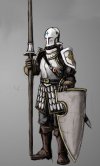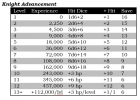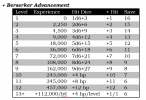Picaroon Jack
And the Brothers Slack
- Joined
- Jul 6, 2018
- Messages
- 4,308
- Reaction score
- 15,695
The Anti-Paladin came up in another thread, so I thought I would start one on Dragon magazine's alternative alignment paladins. I'll try to list all of them in the next few days. I have only had experience with the Anti-Paladin (CE) and the Illrigger (LE)
1. The Anti-Paladin is from Dragon Magazine #39 and is depicted as an NPC but has all the rules to run it as a player. Here is the ability requirements:

Alignment: Chaotic Evil ("Where the Paladin is the champion of all that is Good and Lawful, the Anti-Paladin is the defender of the Powers of Chaos and Evil. By nature, therefore, his alignment is always Chaotic Evil, without exception!")
Here are their class benefits:
1. The Anti-Paladin is from Dragon Magazine #39 and is depicted as an NPC but has all the rules to run it as a player. Here is the ability requirements:

Alignment: Chaotic Evil ("Where the Paladin is the champion of all that is Good and Lawful, the Anti-Paladin is the defender of the Powers of Chaos and Evil. By nature, therefore, his alignment is always Chaotic Evil, without exception!")
Here are their class benefits:
- A +2 bonus on all saving throws.
- Immunity to Disease. And the Anti-Paladin is also a “carrier,” and can transmit the disease of their choice to the character of their choice by touch alone. They may only do this once per week for every five experience levels. ("i.e. at 1st-5th levels, once/week; 6th-10th levels, twice/week, etc.")
- Laying on of Hands. Once a day, the Anti-Paladin may Cause Wounds in others or cure damage to themself, giving/healing two hit points of damage for each acquired experience level. They must do this by touch.
- Protection from Good. This aura extends in a 1” radius around the Anti-Paladin. This is detected with the Detect Magic.
- Thief’s Backstabbing Ability. The Anti-Paladin receives a +4 bonus to hit, with double damage, whenever they hit a victim from behind. Backstabbing is the Anti-Paladin’s preferred method of attack.
- Use of Poisons. The Anti-Paladin favors the poisoned cup over armed combat and they consider poisoning an artistic expression more than a means to kill someone.



 ? I seem to remember they were comparable in combat to paladins when armoured up.
? I seem to remember they were comparable in combat to paladins when armoured up.















